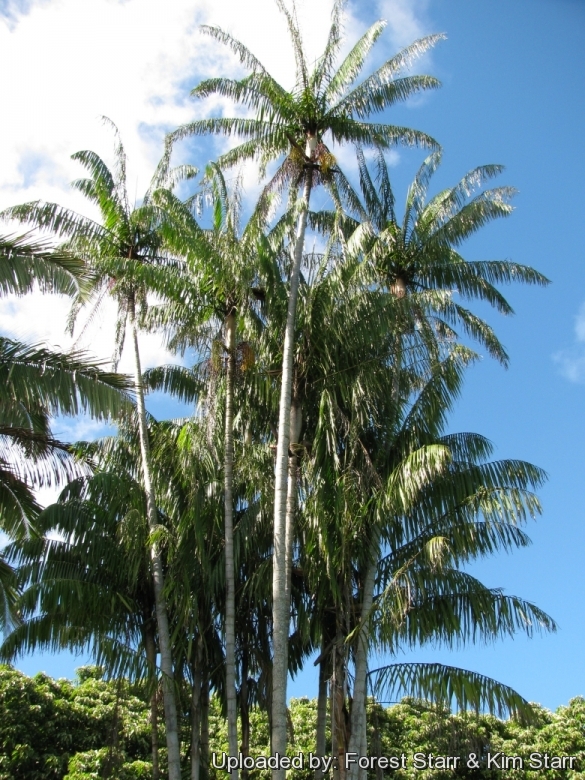
Oncosperma tigillarium Photo by: Forest Starr & Kim Starr
Bark and spines at Kahanu Gardens NTBG Kaeleku Hana, Maui, Hawaii (USA). November 04, 2009.
Origin and Habitat: South-east Asia (Thailand, Malaysia, Sumatra, Java, and the Philippines)
Habitat: It can be found in many coastal areas or other bodies of water of Southeast Asia in swampy rainforest at elevations below 150 metres mainly on the landward fringe of mangrove swamps in lower salinity waters. It is also found in inland freshwater swamp-forests above the highest flood mark or rarely on poor sandy soils. It is naturalized and invasive to a few tropical islands in the Western Hemisphere where it has been planted as an ornamental.
Ecology: Seeds are dispersed by bats, large birds and monkeys. The latter also like to eat the flowers.
Synonyms:
See all synonyms of Oncosperma tigillarium
back
Accepted name in llifle Database:Oncosperma tigillarium (Jack) Ridl.J. Straits Branch Roy. Asiat. Soc. 33: 173 (1864)Synonymy: 8
back
Common Names include:
ENGLISH: Nibong palm, Nibung palm, Wild palm, Nibung
CHINESE (中文): Ni bang ye zi
INDONESIAN (Bahasa Indonesia): Nibung
JAPANESE (日本語): Nipon yashi
KAPAMPAGAN (Kapampangan): Anibong
LITHUANIAN (Lietuvių): Laiboji margapalmė
MALAY (بهاس ملاي /Bahasa Melayu ): Nibung, Pokok Nibung
THAI (ภาษาไทย): หลาวชะโอนทุ่ง, Lao cha on
Description: Oncosperma tigillariumSN|28522]]SN|28522]] is a very attractive cespitose species with droopy leaves and intensely spiny trunks that forms dense thickets of up to 50 palm trees. It is arguably one of the most beautiful palms in the world.
Trunk: Up to 25 m in height, usually only 10-15 cm or up to 25 cm in diameter, slender, straight or slightly curved, greyish, light brown colour, with prominent leaf scar rings covered with long downward or horizontally-spreading spines that are black in colour, flat, 2,5-6,5 cm long. Spines are also all over other plant parts.
Crownshaft: Light green up to 1,5 m long.
Leaves: 2-4 m long, elegantly arched, finely pinnate, with sharp drooping leaflets, uniformly distributed on the rachis and long, in the median part, about 50 cm.
Inflorescence: Ramified and thorny, among the leaves, yellow with flowers of both sexes placed in the typical triad (a feminine flower amidst two masculine ones) The spadix is 30-40 cm wide and longer at crown apex.
Blooming season: Flowers in summer and fruits in winter.
Fruits: Globose, 12 mm about of diameter, green and turning blackish when ripe.
Bibliography: Major references and further lectures
1) Forest & Kim Starr Oncosperma tigillarium (Nibung palm, gendiwung). Plants of Hawaii. <http://www.starrenvironmental.com>. Downloaded on 21 August 2014.
2) John Dransfield, Natalie W. Uhl “Genera Palmarum: the evolution and classification of palms” Kew Pub., 2008
3) Andrew Henderson “Palms of Southern Asia” Princeton University Press, Princeton and Oxford 27/Apr/2009
4) Don Ellison, Anthony Ellison “Cultivated Palms Of The World” UNSW Press, 01/May/2001
5) Govaerts, R. & Dransfield, J. “World Checklist of Palms”. The Board of Trustees of the Royal Botanic Gardens, Kew. 2005.
6) Wikipedia contributors. "Oncosperma tigillarium" Wikipedia, The Free Encyclopedia. Wikipedia, The Free Encyclopedia, Accessed on 28 Aug. 2014
7) Palmpedia contributors. "Oncosperma tigillarium." Palmpedia, PALM ENCYCLOPEDIA, <http://www.palmpedia.net> Downloaded on 26 Aug. 2014
8) Robert Lee Riffle, Paul Craft “An Encyclopedia of Cultivated Palms” Timber Press, Portland 2007
9) "Oncosperma tigillarium." PACSOA Palms and Cycads wiki , <http://www.pacsoa.org.au> Accessed on 28 Aug. 2014
10) Barfod, A.S. & Dransfield, J. (2013). “Flora of Thailand” 11(3): 323-498. The Forest Herbarium, National Park, Wildlife and Plant Conservation Department, Bangkok.
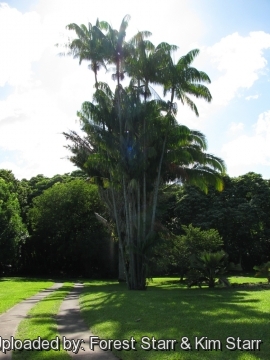 Bark and spines at Kahanu Gardens NTBG Kaeleku Hana, Maui, Hawaii (USA). November 04, 2009. Photo by: Forest Starr & Kim Starr
Bark and spines at Kahanu Gardens NTBG Kaeleku Hana, Maui, Hawaii (USA). November 04, 2009. Photo by: Forest Starr & Kim Starr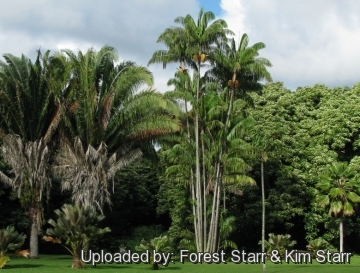 Habit at Kahanu Gardens NTBG Kaeleku Hana, Maui, Hawaii (USA). November 04, 2009. Photo by: Forest Starr & Kim Starr
Habit at Kahanu Gardens NTBG Kaeleku Hana, Maui, Hawaii (USA). November 04, 2009. Photo by: Forest Starr & Kim Starr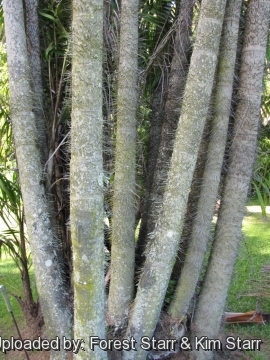 Spiny stems at Kahanu Gardens NTBG Kaeleku Hana, Maui, Hawaii (USA). November 04, 2009. Photo by: Forest Starr & Kim Starr
Spiny stems at Kahanu Gardens NTBG Kaeleku Hana, Maui, Hawaii (USA). November 04, 2009. Photo by: Forest Starr & Kim Starr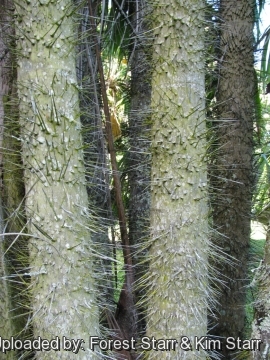 Bark and spines at Kahanu Gardens NTBG Kaeleku Hana, Maui, Hawaii (USA). November 04, 2009. Photo by: Forest Starr & Kim Starr
Bark and spines at Kahanu Gardens NTBG Kaeleku Hana, Maui, Hawaii (USA). November 04, 2009. Photo by: Forest Starr & Kim Starr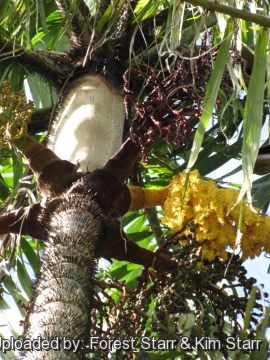 Flowers and fruit at Kahanu Gardens NTBG Kaeleku Hana, Maui, Hawaii (USA). November 04, 2009. Photo by: Forest Starr & Kim Starr
Flowers and fruit at Kahanu Gardens NTBG Kaeleku Hana, Maui, Hawaii (USA). November 04, 2009. Photo by: Forest Starr & Kim Starr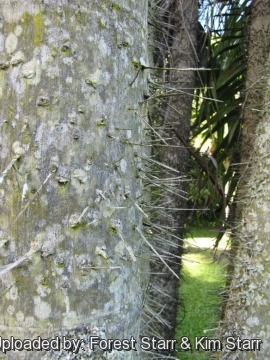 Spiny stems at Kahanu Gardens NTBG Kaeleku Hana, Maui, Hawaii (USA). November 04, 2009. Photo by: Forest Starr & Kim Starr
Spiny stems at Kahanu Gardens NTBG Kaeleku Hana, Maui, Hawaii (USA). November 04, 2009. Photo by: Forest Starr & Kim StarrCultivation and Propagation: Oncosperma tigillariumSN|28522]]SN|28522]] is an excellent fast growing palm easy to recognize from a distance and adapt to tropical and subtropical climates in humid regions, specially along with rainforests. It is considered one of the most ornamental palm for the elegance of the foliage, but is little cultivated, both for the presence of the spines, and for its exigencies of cultivation (particularly it needs sunny, and very moist position).
Soil requirements: It has a fibrous root system and benefits from deep organic, fertile, acidic soils, but thrives on wide range of tropical soils, like coastal marine alluvial clays, soils of volcanic origin, acid sands and other coastal alluviums and even in seasonally flooded areas and swamps. Extremely sandy or stony soils should be avoided.
Watering: It requires elevated moisture, can tolerate temporary flooding or a fluctuating water table, as might be found along rivers.
Light: It needs full sun exposures, but tolerates some shade especially when young. If home-grown, give some sun as with most tropical palms.
Fertilization: Need a perfect fertilizer diet including all micro nutrients and trace elements.
Aerosol salt tolerance: Salt spray as well as mild soil salinity are tolerated.
Hardiness: It is not known to exhibit any cold tolerance and is suited for equatorial, tropical or subtropical climate and seedling growth arrested below 15°C. Mean maximum temperature of 30-32°C and mean minimum of 21-24°C (USDA Zones 11-12), it will be injured and may be killed by freezing temperatures and may show chilling injury symptoms of leaflet necrosis at temperatures as high as 5 degrees C.
Wind hardiness: It is tolerant of wind including bad storms, but will grow better with slow wind.
Garden uses: It is an xcellent landscaping palm if you can water it a lot, a single palm would make an attractive specimen in parks and large gardens and, given it's size and fast growth, a clump of Oncosperma tigillariumSN|28522]]SN|28522]] would really be a sight to behold.
Food use: The asparagus like pulp (palm cabbage) in the centre of the crown is very appreciated and known as the “Millionaires Salad” it is a very expensive vegetable because a whole trunk must be cut down to obtain a limited amount of edible flesh. The palm is not killed by this because it is a clump forming palm and other trunks may grow from it's base, The cabbage can be eaten, raw or cooked.
Other uses: Source of construction materials. Once stripped of its thorns the trunk furnish an extremely hard, durable, elastic, rot resistant and salt water resistant wood which is used for purposes like piling, rafters, flooring, tools, weapons, furniture, fish traps, and in traditional kelong construction. Flowers are used to flavour rice, fruits to make preserves and as substitute for betel. The leaves are used for basketry, roofing and the contain fibres.
Propagation: The fresh seeds germinate easily. If not properly treated, the seed does not have long shelf life.















